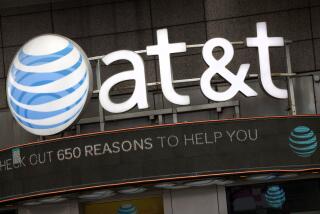Fog Descends Over ‘Open Access’
The debate over whether to require AT&T; to open its high-speed cable system to carry competing Internet service providers has--under the influence of lobbyist money--sunk into mindlessness. The term “open access” almost rivals “un-American” for political spin.
It’s time for a reality check. A decision on this issue by the Los Angeles City Council in the fall will have a profound impact on how voice, video and data will be delivered to area homes and could affect the regional economy.
Those favoring regulation look at the sad history of cable TV performance over 50 years and fear the worst from AT&T;’s new venture into cable. They predict a monopolistic AT&T; will offer information services to the affluent and will manage content by excluding a mix of Net service providers.
But when it comes to growth of the Internet, the past is irrelevant, and the future is all but inscrutable. This is a poor set of circumstances for trying to set long-lasting regulatory policy.
The City Council needs to take a broader definition of “open access.” All forms of Net delivery technology should be given an equal opportunity to reach the vast home Internet market in Los Angeles. By encouraging competition among cable, phone, satellite and other delivery methods, the council will ensure that consumers will get the best deal. Multiple digital pathways into homes--real open access--will create the widest choices of information at the least cost.
The “open access” advocates are dealing in myths. Let’s examine them:
Myth No. 1: Cable-driven broadband access to homes will have an overwhelming advantage over competing delivery systems, such as phone lines.
The fact is that little is known about how broadband cable will function under heavy usage. “Open access” may be technically infeasible. Broadband cable capacity will already be stressed by data-heavy services that are being planned, such as movies, e-commerce and applications for home offices. Also, even if AT&T; has total control of its network, it faces many obstacles in making its system profitable. If it is saddled with regulatory baggage, the effort may not be worth it.
Myth No. 2: Competing high-speed phone services are inferior and not competitive with cable-delivered Internet service.
The fact is that only about 800,000 households nationwide are now on cable modems to access the Internet, compared with about 54 million Internet users in the U.S., including 17 million AOL subscribers, who use phone lines. Many Internet users are now on high-speed phone connections from offices and college residence halls and libraries. They are satisfied digital subscriber line users and are a ready market for home phone connections. Also, high-speed phone lines have several advantages over broadband cable, including the possibility of greater capacity and ease of expansion.
Myth No. 3: Wireless and satellite developers are many years away from delivering voice, video and data to homes efficiently and economically. The fact is that AOL announced in June that it would invest $1.5 billion in Hughes Electronic Corp. so that AOL subscribers could reach the Net from high-speed satellite connections. That action speaks for itself. You can already get a Net connection by installing DirecTV, although that service is slow and uncertain. But this pathway does exist and is highly promising. Telecommunications companies worldwide are investing heavily in satellite- and wireless-delivered data services. This pathway could be the least expensive and most efficient of any alternatives because--when fully designed and implemented--it avoids an expensive wire infrastructure.
Given the uncertainties, these alternatives to “open access” are far more attractive:
* Remove regulatory obstacles--real or imagined--to broadband technology that competes with cable. Stimulating competition to cable access could put the city of Los Angeles in a win-win situation by creating a climate of vigorous communications development where both private enterprise and consumers come out ahead. Tax breaks and other financial incentives could be extended to developers of alternative technologies.
* Extract a reasonable price for approval from AT&T.; Without inhibiting AT&T;’s technical development, regulators could require the company to provide widespread free access to its Internet service, such as at schools, libraries, retirement homes, hospitals and community centers. AT&T; could also be required to agree not to seek control of or inhibit the growth of alternative Net pathways.
* AT&T; should be put on notice that in return for a regulation-free environment, it will face close scrutiny in the future. If, at any time, AT&T; threatens to create a monopoly on Internet delivery, regulations still could be imposed. That is the sensible--and legal--way to require open access.
More to Read
Sign up for Essential California
The most important California stories and recommendations in your inbox every morning.
You may occasionally receive promotional content from the Los Angeles Times.










